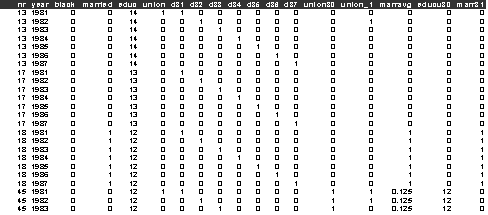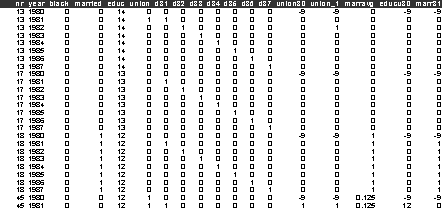Exercise FOL1 Trade Union
Membership 1980-1987 of young males, Wooldridge (2005)
Wooldridge (2005) used the data from Vella and Verbeek (1998) on the
binary response trade union membership to illustrate his treatment of the
initial conditions problem in first order Markov models. We will estimate a
range of other models on the same data in this exercise. The Vella and Verbeek (1998) data are
from the National Longitudinal Survey (Youth Sample) and consist of a sample of
545 full-time working males who have completed their schooling by 1980 and who
are then followed from 1980 to 1987. Trade union membership is determined by
the question of whether or not the sampled individual had his wage set in a
collective bargaining agreement or not. Wooldridge used the time-constant
covariates of educ (years of schooling) and race
(black or not), and the time-varying covariate of marital status.
References
Vella,
F., Verbeek, M., (1998), Whose
wages do Unions raise? A dynamic Model of Unionism and wage rate determination
for young men, Journal of Applied Econometrics, 13, 163-183
Wooldridge, J.M., (2005), Simple solutions to the
initial conditions problem in dynamic, nonlinear panel data models with
unobserved heterogeneity, Journal of Applied Econometrics, 20, 39-54.
Conditional analysis
Data description
(unionjmw1.dat):
Number of observations (rows): 3815:
Number of level-2 cases (`nr'): 545
Number of variables (columns): 24
The variables include the following:
nr= respondent
identifier
year=
calendar year 1981-1987
black=1
if respondent is classified as black, 0 otherwise
married=1
if respondent is currently married, 0 otherwise
educ=years of education
union=1
if wage set by collective bargaining, 0 otherwise in current year
d81=1 if year is 1981, 0 otherwise
d82=1 if year is 1982, 0 otherwise
d83=1 if year is 1983, 0 otherwise
d84=1 if year is 1984, 0 otherwise
d85=1 if year is 1985, 0 otherwise
d86=1 if year is 1986, 0 otherwise
d87=1 if year is 1987, 0 otherwise
union80=1 if wage set by collective bargaining in
1980, 0 otherwise
union_1= lagged 1 year value of union variable
marravg=
average value of married over 1980-1987
educu80= years of education for those in full-time
education in 1980
marr81=1 if respondent was married in 1981, 0
otherwise
marr82=1 if respondent was married in 1982, 0
otherwise
marr83=1 if respondent was married in 1983, 0
otherwise
marr84=1 if respondent was married in 1984, 0
otherwise
marr85=1 if respondent was married in 1985, 0
otherwise
marr86=1 if respondent was married in 1986, 0 otherwise
marr87=1 if respondent was married in 1987, 0
otherwise
The first few rows and columns of unionjmw1.dat
look like:

Exercise
1)
Estimate a random effect probit
model (mass 24) of trade union membership (union), with a constant, the lagged
union membership variable (union_1), educ, black and
the marital status dummy variable (married), the marr81-marr87 and the d81-d87
sets of dummy variables.
2)
Add the initial condition of trade union membership
in 1980 (union80) to the previous model. How does the inference
on the lagged response (union_1) and the scale parameter differ between the two
models?
Joint analysis of the
initial condition and subsequent responses
Data description
(unionjmw2.dat)
Number of observations (rows): 4360:
Number of level-2 cases (`nr'): 545
Number of variables (columns): 27
The variables are the same as unionjmw1.dat with
the addition of d, d1 and d2 at the end of the list, with
d=1, for the initial response, 2 if a subsequent
response
d1=1 if d=1, 0 otherwise
d2=1 if d=2, 0 otherwise
The first few rows and columns of unionjmw2.dat
look like:

Exercise
1)
Estimate a common random effect common scale
parameter joint probit model (mass 24) of trade union
membership (union). Use the d1 and d2 dummy variables to set up the linear
predictors. Use constants in both linear predictors. For the initial response,
use the married, educ and black regressors.
For the subsequent response, use the regressors:
lagged union membership variable (union_1), educ,
black and the marital status dummy variable (married), the marr81-marr87 and
the d81-d87 sets of dummy variables. What does this model suggest about state
dependence and unobserved heterogeneity?
2)
Re-estimate the model allowing the scale parameters
for the initial and subsequent responses to be different. Is this a significant
improvement over the common scale parameter model?
3)
To the different scale parameter model, add the
baseline response (union80). Does this make a significant improvement to the
model?